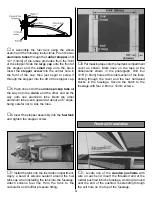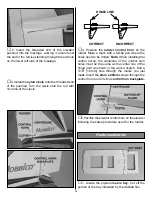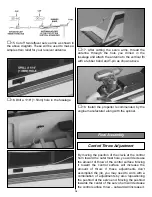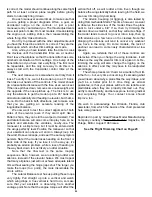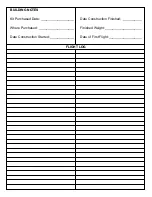
shall be used to supervise flying to avoid having
models fly in the proximity of full-scale aircraft.
3. Where established, I will abide by the safety
rules for the flying site I use and I will not willfully
and deliberately fly my models in a careless,
reckless and/or dangerous manner.
7. I will not fly my model unless it is identified with
my name and address or AMA number, on or in
the model.
9. I will not operate models with pyrotechnics (any
device that explodes, burns, or propels a projectile
or any kind).
Radio Control
1. I will have completed a successful radio
equipment ground check before the first flight of a
new or repaired model airplane.
2. I will not fly my model aircraft in the presence of
spectators until I become a qualified flier, unless
assisted by an experienced helper.
3. I will perform my initial turn after takeoff away
from the pit or spectator areas and I will not
thereafter fly over pit or spectator areas, unless
beyond my control.
4. I will operate my model using only radio control
frequencies currently allowed by the Federal
Communications Commission.
You will find the Hobbistar 60 MKII a predictable,
easy flying airplane. The plane is very good for
learning how to fly and will allow you to proceed
into some advanced flying maneuvers once you
have learned the basics.
Before the first flight it is a good idea to taxi the
plane on the ground to get a feel for the ground
handling characteristics of the plane. Once you feel
comfortable with the way it taxis, it is time to line it
up on the end of the runway. Slowly advance the
throttle and use the rudder / nose wheel steering to
maintain a straight run down the runway. When the
airplane begins to pick up significant speed, slowly
pull back on the elevator stick on your radio.
Maintain a gentle climbing attitude until the plane is
approximately 75 feet high, then begin a turn away
from the pit area.
Once airborne, you will find that the plane is a very
predictable and docile flyer. Until you are very
comfortable with the plane, it is recommended that
you practice gentle turns, both to the left and the
right. Once you are comfortable with making both
right and left hand turns you may want to
experiment with rolls and loops. The plane is
capable of most all of the flying maneuvers a
newcomer will ever want to learn.
When it is time to land the plane, set up straight in line
with the end of the runway at approximately 75 feet.
Gradually begin to decrease the power and the plane
will begin to descend. Maintain the wings in a level
Landing
CAUTION (THIS APPLIES TO ALL R/C
AIRPLANES): If, while flying, you notice any
unusual sounds, such as a low-pitched “buzz,” this
may be an indication of control surface “flutter.”
Because flutter can quickly destroy components of
your airplane, any time you detect flutter you must
immediately cut the throttle and land the airplane!
Check all servo grommets for deterioration (this will
indicate which surface fluttered), and make sure all
pushrod linkages are slop-free. If it fluttered once, it
will probably flutter again under similar circumstances
unless you can eliminate the slop or flexing in the
linkages. Here are some things which can result in
flutter: Excessive hinge gap; Not mounting control
horns solidly; Sloppy fit of clevis pin in the control
horn; Elasticity present in flexible plastic pushrods;
Side-play of pushrod in guide tube caused by tight
bends; Sloppy fit of Z-bend in servo arm;
Insufficient glue used when gluing in the elevator
joiner wire or aileron torque rod; Excessive flexing
of aileron, caused by using too soft balsa aileron;
Excessive “play” or “backlash” in servo gears; and
Insecure servo mounting.
Flying
Takeoff
Flying
20







